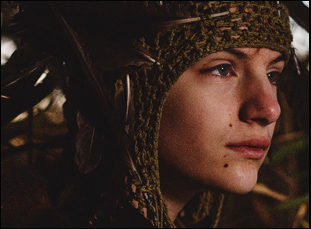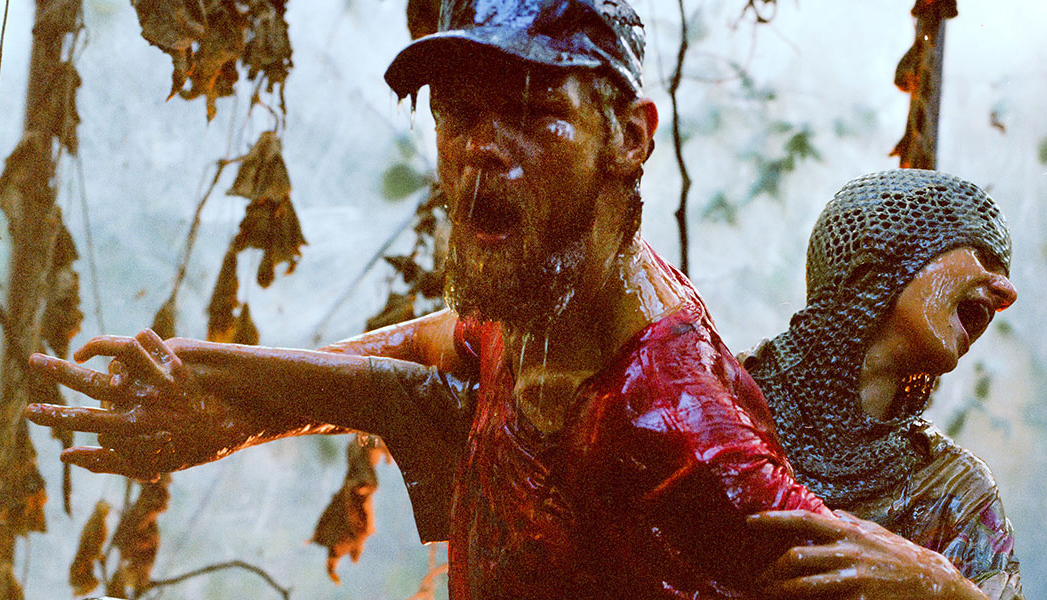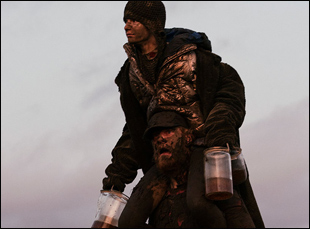In the opening moments of “Resin,” you come to believe that Jens (Peter Plaugborg) and Maria (Sofie Gråbøl) have suffered the most unimaginable loss when their car has tumbled into the sea and their daughter Liv (Vivelill Søgaard Holm) is thought to be a casualty. However, director Daniel Joseph Borgman has something different up his sleeve in his adaptation of Ane Riel’s novel “Harpiks” (penned by Bo hr. Hansen), when it turns out that Liv is very much alive as a teenager when the film jumps ahead a decade, only much of the world doesn’t know it as she resides with Jens and Maria in the middle of a forest. Taught to be a survivalist, she only has passing knowledge of civilization, largely imparted by Jens, who describes those who lead an urban life in contempt, yet the two of them may be forced to deal with city folk when Maria needs medication for her pregnancy, which has kept her confined to her bed.
Although it becomes clear that Liv is in an unhealthy situation being equally confined to the country home out of the fear her father instilled in her, Borgman creates such an all-encompassing world for the characters to inhabit in “Resin” that it’s understandable why Liv could never imagine there’s anything outside of it. Gliding around the house they share, shrouded in foliage and wildlife running all about, the director makes sure that the drama going on inside of it is even livelier as Liv confronts the possibility that her father may have been misguided in his best intentions for her and develops her own sense of judgment, realizing that perhaps a cup of nettle tea with raspberry leaves isn’t going to cure what ails her mother. While the film has elements of a gothic fairy tale, it is a fascinating story of a young woman coming into her own and a man unraveling in middle age when gripped by fear to the point he can no longer discern reality.
On the eve of the film’s premiere at the Toronto Film Festival, Borgman spoke about striking just the right tone with the film, finding the right father and daughter for it and how capturing a change of seasons led to a particularly unenviable job for his assistant.
I was commissioned to make the film by Peter Aalbaek, who owns Zentropa in Denmark, and he asked myself and my longtime producer Katja Adomeit if we would join them and make this movie, and I read it, and it took me awhile to find my own way into it, but what really mattered to me was to figure out a unique way to tell a story because the premise is quite clear, but [I wanted] to do it in a way that has some sensibility or some texture.
It does hit that sweet spot between fantasy and reality. Was that difficult to achieve?
It’s based on a book and what’s interesting about reading the book and then thinking about taking it to the screen is that the book itself is even more of a fairy tale. Denmark has this history of making these social realist films, and I’m just not interested in doing that. So it was [a challenge of] bringing it onto the screen in a way that’s plausible, but also trying to make it something that’s more of an impression on the audience rather than a socially realistic portrait.
You mention texture, which manifests itself in a very tactile way in the film. Was there anything specific you did to get that look?
We shot on 16 mm anamorphic, which I think has maybe been done four times in [features], and I really wanted to shoot on film and because my previous film was on film, and there’s something about how you work when you shoot on film and also how you relate to the results that’s different and special. I also really wanted to light the film with natural light or fire, [because] a lot of the film was about getting close to the organic sense of the world, so this was another layer of getting close to something that is more alive.
How did you find this forest setting?
We built the house in the location because it’s really hard to find a place in the forest that you can access so you can make a film. What was really important to me was to be able to have a live set in that Terrence Malick style where you can go in and out of all the rooms, and you don’t have to shift [the lighting], so even though the house was made for the film, it’s fully functional and you can go in and walk up the stairs and go through all the rooms. It was good because we were accommodated right beside this forest, and then I was able to spend time on the location with the actors and just be open for whatever sort of gifts that nature will give to us. Obviously being able to change how you shoot or when you shoot based on the light is really a privilege and watching the seasons change.
We shot from late summer into the beginning of autumn, and the film has this downward progression, so we got to experience that in a kind of metaphorical sense in terms of the changing of the season and made us all closer to the world of the film because we were so close for such a long time to this forest lifestyle. The closing shot was found just by walking around in the last couple of weeks, just thinking, “Oh, we should just be here.” So much in terms of where we staged things and how they were staged was to do with responding to the environment.

Yeah, things like that are never easy, so my assistant Jackie spent a lot of time figuring out how to do that and then a lot of time wrapped up in a face mask in full biohazard gear hanging out in a container. I think we changed him as a person. [laughs] He smelled really bad actually.
How did you find your wonderful father and daughter for this?
I’ve always wanted to work with Peter, who plays the dad. He’s an amazing Danish acting talent and I had my eye on him for a long time. Then Viv who plays Liv, we found from street casting and it was really interesting because we requested that children who were interested in being in the film do a self tape of themselves as an animal to send in. [Viv’s] was the first where I thought, “Oh, this is the girl,” and then she ended up being the girl, [which] doesn’t often happen. Usually, you get a self tape that’s really good, but there may be these other reasons that you can’t cast the child, so it was quite special that she just like stuck out from the start. And then we thrashed her through a bunch of rehearsals and whatever coaching, but then it was the best takeaway from making the film was seeing her go from being this timid child to this powerful young woman. It was really, yeah, really special to have had that time with her.
When you go through that rehearsal process, is there anything that you’re seeing that you may not have anticipated, but you incorporate into the film?
We quite often had it. Because we were staying [right] beside the location, maybe if we got a bit ahead [in the shoot], or we knew we had a little gap or we were waiting for the weather, we could run off and do some improvisational stuff. I’m a big fan of having the script be like a frame, and be as free as much as possible inside the frame that you’ve created and so long as you know what you need to do in the scene, then you can adjust it as you go. Peter was very involved in developing his character, trying very hard to make sure that his character wasn’t just a villain, but a complicated person who was suffering.
What’s it like getting to the finish line?
Getting to the finish line is always good. This is my first time in Toronto, my other films have premiered in European festivals generally, so I didn’t know what to expect, but it’s exceeded all my expectations. The kind of exposure you get here is amazing, and it’s just been a real pleasure to be here, and to be in the city, and looking forward to showing people the film and see what happens.
“Resin” does not yet have a U.S. distributor. It will be released in Denmark on December 12th.





